Informal Settlement Resilience Upgrading-Approaches and Applications from a Cross-Country Perspective in Three Selected Metropolitan Regions of Southeast Asia
Abstract
:1. Introduction
- (1)
- How the city-region spatial conditions and development look like in the three metropolis regions? What are the interactions of urban growth, informality, and informal settlements?
- (2)
- What are the central strategies regarding existing informal urbanization, informality, and proliferation of informal settlements?
- (3)
- What is the role of informal settlement on-site upgrading in terms of its integration with resiliency and disaster risk mitigation? (needs, gaps, and achievement, etc.)
- (4)
- How does climate change affect the management of upgrading informal settlements? Climate change alters exposure. Informal settlements that were not previously at risk may be in future.
- (5)
- How is the performance of on-site upgrading in conjunction with citywide development? (potentials and impediments; possible mechanisms/tools to promote on-site upgrading?)
2. Materials and Methods
- (1)
- There are two sets of online questionnaires, including both pre-workshop via LimeSurvey and a real-time Zoom polling with ca. 42 participants during the October 2020 workshop. Particularly need to mention, Indonesia was involved at the beginning of the research activities, e.g., in the workshops and online survey. The country has a good experience on informal settlement upgrading. Along with the research development, the project LIRLAP identifies its focus on the other three countries.
- (2)
- The questionnaire results were jointly discussed and validated during the workshop in November 2021. The thematic areas are (a) alternative land and housing tenure; and (b) application of land readjustment for citywide upgrading. This workshop was able to get four resource persons, who contributed to the thematic discussions on Metro Manila. Philippine participants included those from National Economic and Development Authority, National Housing Authority, Housing and Land Use Regulatory Board, Social Housing Finance Corporation, Department of Public Works and Highway, Philippine Statistics Authority, Philippine Volcanologist and Seismologist and Metro Manila Development Authority and three Local Government Units (the City of Valenzuela, Quezon and Marikina), etc.
- (3)
- In July 2021, two online workshops took place respectively, targeting Hanoi (47 participants) and Bangkok (34 participants) with all project partners of the three countries. The themes covered aspects of upgrading hotspots, upgrading scales, main actors, upgrading approaches, challenges, criticism, and lessons learnt, etc. Participants included those Vietnam representatives from the Ministry of Natural Resources and Environment, Faculty of Natural Resources and Environment, Vietnam National University of Agriculture, Consultant Center of Science Technology for Natural Resources and Environment Hanoi, Hanoi Urban Planning Institute and Land Use Planning Department, Southern Institute of Water Resources Research, Land Registration Authority of Long Bien District of Hanoi, etc. Thai representatives were from Geo-Informatics and Space Technology Development Agency, Department of Public Works and Town and Country Planning, Community Organizations Development Institute (CODI), Thammasat University Research Unit in Urban Futures and Policy, etc.
3. Informal Settlements, Informality and Urban Growth under Regional Conditions
3.1. Proliferation of Informal Settlements in Metro Manila
3.2. Stability of Informal Settlements in Bangkok Metropolitan Region
3.3. Emergence of Informal Settlements and Comprehension of Informality in Hanoi Capital Region
4. On-Site Upgrading Undertakings in Three Metropolitan Regions
4.1. Metro Manila—From Zonal Improvement Program Era to Community Resilience Building
4.2. Bangkok Metropolitan Region—Community Driven Upgrading with the National Institutional Support
- (1)
- Location-based development promoting self-organized communities;
- (2)
- Toward structural and policy change through collaboration between local communities and relevant stakeholders;
- (3)
- Capacity building of community organization networks;and
- (4)
- Developing management system for community organization.
4.3. Hanoi Capital Region—Revitalization of Socialism Legacy along with Urban Expansion
5. Discussions and Contemplations
5.1. Strategies of Informal Settlement Upgrading and Its Role in Building Resilience
5.2. Status, Challenges, and Demands of Resilience Upgrading for Disaster Risk Mitigations and Climate Change Adaptation
5.2.1. Metro Manila
5.2.2. Bangkok Metropolitan Region
- (1)
- Above all, the role of Thai cities in climate change adaption is unclear.
- (2)
- There lacks a clear definition of risk areas aligned with upgrading site selection.
- (3)
- There is no agreed budget scope for adjusting settlement and building design standards to cope with natural disasters.
- (4)
- In Thailand, building codes are not discussed in the context of flood management or climate change.
- (5)
- There need flood retaining areas to accommodate seasonal flooding in BMA, e.g., reserving agricultural areas in Bangkok for this purpose. Such need shall not be considered in the framework of on-site upgrading.
5.2.3. Hanoi Capital Region
- (1)
- Lack of reliable and accurate database to forecast and setting goals and strategies;
- (2)
- Only few detailed guidance has been legalized which are bases for execution; and
- (3)
- Lack of cooperative actions on planning natural disaster prevention among provinces, hence at the local level.
5.3. Performance of On-Site Upgrading in Conjunction with Citywide Development
6. Conclusions and the Way Ahead
Author Contributions
Funding
Institutional Review Board Statement
Informed Consent Statement
Data Availability Statement
Conflicts of Interest
References
- Sendai Framework for Disaster Risk Reduction 2015–2030; United Nations Office for Disaster Risk Reduction (UNISDR): Geneva, Switzerland, 2015.
- UNHABITAT. The New Urban Agenda. Habitat III. 2017. Available online: https://habitat3.org/the-new-urban-agenda/ (accessed on 1 November 2020).
- United Nations. SDG Indicators -Goal 11: Make Cities and Human Settlements Inclusive, Safe, Resilient and Sustainable. 2020. Available online: https://unstats.un.org/sdgs/report/2020/goal-11/ (accessed on 11 January 2021).
- Mach, K.J.; Siders, A.R. Reframing strategic, managed retreat for transformative climate adaptation. Science 2021, 372, 1294–1299. [Google Scholar] [CrossRef] [PubMed]
- Du, J.; Greiving, S. Reclaiming On-Site Upgrading as a Viable Resilience Strategy-Viabilities and Scenarios through the Lens of Disaster-Prone Informal Settlements in Metro Manila. Sustainability 2020, 12, 10600. [Google Scholar] [CrossRef]
- Scott, M.; Lennon, M.; Tubridy, F.; Marchman, P.; Siders, A.; Main, K.L.; Herrmann, V.; Butler, D.; Frank, K.; Bosomworth, K.; et al. Climate Disruption and Planning: Resistance or Retreat? Plan. Theory Pr. 2020, 21, 125–154. [Google Scholar] [CrossRef] [Green Version]
- Greiving, S.; Du, J.; Puntub, W. Managed Retreat—A Strategy for the Mitigation of Disaster Risks with International and Comparative Perspectives. J. Extrem. Events 2018, 05, 1850011. [Google Scholar] [CrossRef]
- World Risk Report 2021; Ruhr University Bochum—Institute for International Law of Peace and Armed Conflict (IFHV): Bochum, Germany, 2021.
- Global Facility for Disaster Reduction and Recovery (GFDRR). GFDRR Annual Report 2017—Bringing Resilience to Scale—World. ReliefWeb. 2017. Available online: https://reliefweb.int/report/world/gfdrr-annual-report-2017-bringing-resilience-scale (accessed on 2 February 2022).
- Making Development Sustainable: The Future of Disaster Risk Management; United Nations Office for Disaster Risk Reduction (UNISDR): Geneva, Switzerland, 2015.
- World Bank. Philippines Urbanization Review: Fostering Competitive, Sustainable and Inclusive Cities. 2017. Available online: https://openknowledge.worldbank.org/handle/10986/27667 (accessed on 15 May 2021).
- Philippine Statistics Authority. Philippine Population Density. 2015. Available online: https://psa.gov.ph/content/philippine-population-density-based-2015-census-population (accessed on 10 May 2022).
- Estoque, R.C.; Murayama, Y. Intensity and Spatial Pattern of Urban Land Changes in the Megacities of Southeast Asia. Land Use Policy 2015, 48, 213–222. [Google Scholar] [CrossRef]
- Philippine Statics Authority. Highlights of the National Capital Region (NCR) Population 2020 Census of Population and Housing (2020 CPH)|Philippine Statistics Authority. 2021. Available online: https://psa.gov.ph/content/highlights-national-capital-region-ncr-population-2020-census-population-and-housing-2020 (accessed on 30 May 2022).
- Atlas of Urban Expansion—Manila. Available online: http://www.atlasofurbanexpansion.org/cities/view/manila (accessed on 26 May 2022).
- Naerssen, T. Urban Social Movements in the Third World, 1st ed.; Schuurman, F., Naerssen, T., Eds.; Routledge: London, UK, 1989. [Google Scholar] [CrossRef]
- Shatkin, G. Planning to Forget: Informal Settlements as “Forgotten Places” in Globalising Metro Manila. Urban Studies 2004, 41, 2469–2484. [Google Scholar] [CrossRef]
- Shatkin, G. The City and the Bottom Line: Urban Megaprojects and the Privatization of Planning in Southeast Asia. Environ. Plan. A. 2008, 40, 383–401. [Google Scholar] [CrossRef]
- Choi, N. Metro Manila through the gentrification lens: Disparities in urban planning and displacement risks. Urban Studies 2016, 53, 577–592. [Google Scholar] [CrossRef]
- UNHABITAT. Slums of the World: The Face of Urban Poverty in the New Millennium. 2003. Available online: https://unhabitat.org/slums-of-the-world-the-face-of-urban-poverty-in-the-new-millennium (accessed on 6 May 2022).
- Habitat-III-Issue-Paper-22_Informal-Settlements-2.0 (2). Available online: https://unhabitat.org/sites/default/files/download-manager-files/Habitat-III-Issue-Paper-22_Informal-Settlements-2.0%20%282%29.pdf (accessed on 6 May 2022).
- Philippine Development Plan 2011–2016; National Economic and Development Authority (NEDA): Pasig City, Philippines, 2011.
- Morin, V.M.; Ahmad, M.M.; Warnitchai, P. Vulnerability to typhoon hazards in the coastal informal settlements of Metro Manila, the Philippines. Disasters 2016, 40, 693–719. [Google Scholar] [CrossRef] [PubMed]
- National Economic and Development Authority (NEDA). Philippine Development Plan 2017–2022. (abridged version); 2017. Available online: http://www.neda.gov.ph/wp-content/uploads/2017/12/Abridged-PDP-2017-2022_Final.pdf (accessed on 1 November 2020).
- ICF (2014). Developing a National IFs Upgrading Strategy for the Philippines-Final Report. 2014. Available online: https://www.google.com/search?q=ICF+(2014).+Developing+a+National+IFs+Upgrading+Strategy+for+the+Philippines-+Final+Report&oq=ICF+(2014).+Developing+a+National+IFs+Upgrading+Strategy+for+the+Philippines-+Final+Report&aqs=chrome..69i57.1431j0j7&sourceid=chrome&ie=UTF-8 (accessed on 10 January 2021).
- World Bank. Climate Risks and Adaptation in Asian Coastal Megacities: A Synthesis. Yumpu.com. 2010. Available online: https://www.yumpu.com/en/document/view/45806137/climate-risks-and-adaptation-in-asian-coastal-megacities-a-synthesis (accessed on 6 May 2022).
- World Bank. Climate Change Impact and Adaptation Study for Bangkok Metropolitan Region: Final Report; World Bank: Washington, DC, USA, 2009; Available online: https://openknowledge.worldbank.org/handle/10986/3113 (accessed on 16 May 2022).
- Atlas of Urban Expansion—Bangkok. Available online: http://www.atlasofurbanexpansion.org/cities/view/Bangkok (accessed on 24 May 2022).
- Burapatana, T.; Ross, W. Chapter 7. Bangkok: Suburbanizing and Unsustainable. Environ. Nat. Resour. J. 2007, 5, 59–68. [Google Scholar]
- Statistical Profile of Bangkok Metropolitan Administration; Strategy and Evaluation Department Bangkok Metropolitan Administration: Bangkok, Thailand, 2016.
- Kermel-Torrès, D. (Ed.) Bangkok and the Bangkok Metropolitan Region. In Atlas of Thailand: Spatial Structures and Development, Atlas et cartes, IRD Éditions; Silkworm Books: Chiang Mai, Thailand, 2020; pp. 151–159. Available online: http://books.openedition.org/irdeditions/32577 (accessed on 23 May 2022).
- World Bank. Population Living in Slums—Thailand|Data. 2020. Available online: https://data.worldbank.org/indicator/EN.POP.SLUM.UR.ZS?end=2017&locations=TH&st=null (accessed on 10 May 2022).
- Bangkok Communities Statistical Report; Bangkok Metropolitan Administration: Bangkok, Thailand, 2018. (In Thai)
- Baan Mankong Thailand’s National, Peopledriven, Collective Housing Program; Community Organizations Development Institute (CODI): Bangkok, Thailand, 2019.
- Yap, K.S.; Leeruttanawisut, K. Informal Settlements in Bangkok: Origins, Features, Growth and Prospects; Routledge: London, UK, 2017. [Google Scholar]
- Kamalipour, H. Forms of informality and adaptations in informal settlements. ArchNet-IJAR 2016, 10, 60. [Google Scholar] [CrossRef]
- Endo, T. Living with Risk: Precarity & Bangkok’s Urban Poor; NUS Press: Singapore, 2014. [Google Scholar] [CrossRef]
- Burapatana, T.; Ross, W. Improving the Quality of Life in Bangkok via Change in City Planning. J. Popul. Soc. Stud. 2011, 20, 25–42. Available online: https://so03.tci-thaijo.org/index.php/jpss/article/view/84529 (accessed on 2 February 2022).
- World Bank Group; Asian Development Bank. Climate Risk Country Profile: Vietnam; World Bank: Washington, DC, USA, 2021. [Google Scholar] [CrossRef]
- Leducq, D.; Scarwell, H.J. The New Hanoi: Opportunities and Challenges for Future Urban Development. Cities 2018, 72, 70–81. [Google Scholar] [CrossRef]
- Duan, H.D.; Shibayama, M. Studies on Hanoi Urban Transition in the Late 20th Century Based on GIS/RS. Jpn. J. Southeast Asian Studies 2009, 46, 532–546. [Google Scholar] [CrossRef]
- Nguyen, T.; Lin, T.H.; Chan, H.P. The Environmental Effects of Urban Development in Hanoi, Vietnam from Satellite and Meteorological Observations from 1999–2016. Sustainability 2019, 11, 1768. [Google Scholar] [CrossRef] [Green Version]
- Minnery, J.; Argo, T.; Winarso, H.; Hau, D.; Veneracion, C.C.; Forbes, D.; Childs, I. Slum upgrading and urban governance: Case studies in three South East Asian cities. Habitat Int. 2013, 39, 162–169. [Google Scholar] [CrossRef]
- Ngo, K.; Gao, Y. Transformation of urban villages in the city of Hanoi, Vietnam. In Health: The Design, Planning and Politics of How and Where We Live; Architecture Media Politics Society: Bristol, UK, 2018; pp. 53–63. Available online: https://pure.hud.ac.uk/en/publications/transformation-of-urban-villages-in-the-city-of-hanoi-vietnam (accessed on 16 May 2022).
- Quezon City: The People’s Homesite and Housing Projects—Lakbay ng Lakan. Available online: https://lakansining.wordpress.com/2020/01/30/quezon-city-the-peoples-homesite-and-housing-projects/ (accessed on 31 May 2022).
- BLISS-Bagong Lipunan Improvement of Sites and Services. Available online: https://kbl.org.ph/bliss-bagong-lipunan-improvement-of-sites-and-services/ (accessed on 31 May 2022).
- Compilation of Research Studies on the Upgrading Projects in Metro Manila; National Housing Authority: Bangkok, Thailand, 1985.
- Republic Act No. 7279; Congress of the Philippines: Manila, Philippines, 1992.
- Doherty, J.F. The Philippine Urban Poor. 1985. Available online: http://hdl.handle.net/10125/15294 (accessed on 2 June 2022).
- Typhoon Ketsana. Wikipedia. 2022. Available online: https://en.wikipedia.org/w/index.php?title=Typhoon_Ketsana&oldid=1087677253 (accessed on 31 May 2022).
- High Density Housing Program—Social Housing Finance Corporation. Available online: https://www.shfc.dhsud.gov.ph/high-density-housing-prgm/ (accessed on 2 June 2022).
- Novero, J.A.S.; Solidum, M.A.B. A Case Study of the Bago Aplaya Settlers Homeowners Association (BASHA), Davao City; BASHA: Davao City, Philippines, 2021. [Google Scholar]
- Fast Facts—Social Housing Finance Corporation. Available online: https://www.shfc.dhsud.gov.ph/cmp-fast-facts/ (accessed on 2 June 2022).
- Ballesteros, M.M.; Llanto, G. Social Inclusion and Housing: Evidence from the Philippines—PDF Free Download. Available online: https://docplayer.net/28078189-Social-inclusion-and-housing-evidence-from-the-philippines.html (accessed on 2 June 2022).
- Congress of the Philippines. Republic Act No. 9207|GOVPH. Official Gazette of the Republic of the Philippines. 2002. Available online: https://www.officialgazette.gov.ph/2003/05/17/republic-act-no-9207-2/ (accessed on 31 May 2022).
- Congress of the Philippines. R.A. No. 10023. 2009. Available online: https://lawphil.net/statutes/repacts/ra2010/ra_10023_2010.html (accessed on 31 May 2022).
- Congress of the Philippines. Republic Act No. 10752. 2015. Available online: https://lawphil.net/statutes/repacts/ra2016/ra_10752_2016.html (accessed on 31 May 2022).
- Cipriano, F.; Ledda, K.M. A Case Study on Isf Resilience Upgrading: Community Development Initiatives and Programs of Riverview Homeowners Association, Inc. (RVHOA) in Iloilo City; RVHOA: Iloilo City, Philippines, 2021. [Google Scholar]
- Dadulla, L.B.; Esplana, I.R. A case study of Del Rosario Compound Neighborhood Association, Inc. (DRCNAI); DRCNAI: Valenzuela City, Philippines, 2021. [Google Scholar]
- De Rosas-Ignacio, M.A. Credit and Savings Cooperative (K-COOP), Kabuhayan sa Ganap na Kasarinlan (KASAGANA KA); KASAGANA KA: Quezon, Philippines, 2020. [Google Scholar]
- Adarne, F.I.A.; Salazar, A.E.R.U. Approaches to Resilience Upgrading in ISF Communities: A Case of Ang Payatas Scavengers Homeowners Association, Inc. (APSHAI); APSHAI: Barangay, Philippines, 2021. [Google Scholar]
- Senanuch, P. An Investigation into the Policy for Urban Poverty Alleviation in Thailand through the Study of Urban Slum Communities. Ph.D. Thesis, The University of Sydney, Sydney, Australia, 2004. Available online: https://ses.library.usyd.edu.au/handle/2123/1982 (accessed on 16 May 2022).
- Yap, K.S.; De Wandeler, K. Self-Help Housing in Bangkok. Habitat Int. 2010, 34, 332–341. [Google Scholar] [CrossRef]
- Doling, J. Housing Policies and the Little Tigers: How Do They Compare with Other Industrialised Countries? Hous. Stud. 1999, 14, 229–250. [Google Scholar] [CrossRef]
- Jonsson, H. Review of Inside Thai Society: Religion, Everyday Life, Change. J. Asian Studies 2002, 61, 784–786. [Google Scholar] [CrossRef]
- Garschagen, M. Urban Upgrading and Resettlement of Slum Dwellers in the Mekong Delta—Long-Term Sustainability or Vulnerability Pitfall? In Proceedings of the International Workshop on Socio-Economically Sustainable Development in Vietnam, Hanoi, Vietnam, 1–3 December 2010; p. 14. [Google Scholar]
- Anh, N.T.; Minh, P.Q. Responses to Flooding: Migrants’ Perspectives in Hanoi, Vietnam. In Living with Floods in a Mobile Southeast Asia; Routledge: London, UK, 2017. [Google Scholar]
- World Bank. Vietnam’s Urbanization at a Crossroads: Embarking on an Efficient, Inclusive, and Resilient Pathway; World Bank: Washington, DC, USA, 2020. [Google Scholar] [CrossRef]
- Kimhur, B. When Communities Transform Old Socialist Housing into Adequate Housing—Part 1. Urbanet. 2019. Available online: https://www.urbanet.info/when-communities-transform-old-socialist-housing-into-adequate-housing-part-1/ (accessed on 12 May 2022).
- United Nations Office for Disaster Risk Reduction (UNDRR). Global Assessment Report on Disaster Risk Reduction 2019; UN Office for Disaster Risk Reduction. 2019. Available online: http://digitallibrary.un.org/record/3825375 (accessed on 23 November 2020).
- The National Disaster Risk Reduction and Management Plan; The National Disaster Risk Reduction & Management Council (NDRRMC): Quezon City, Philippines, 2011; p. 69.
- Closing the Gap in Affordable Housing in the Philippines: Policy Paper for the National Summit on Housing and Urban Development; World Bank: Washington, DC, USA, 2016.
- Rerngnirunsathit, P. Thailand Country Profiles 2011; DDPM: Bangkok, Thailand, 2012; p. 23. [Google Scholar]
- Bangkok Urban Planning and Development & Climate Resilient Integration; BMA City Planning and Urban Development Department: Bangkok, Philippines, 2020.
- Nguyen, H.; Tran, P. Urban Disaster Risk Reduction in Vietnam. In Urban Disasters and Resilience in Asia; Elsevier: Amsterdam, The Netherlands, 2016; pp. 123–140. [Google Scholar] [CrossRef]
- Statista. Vietnam: Distribution of Population between Urban and Rural Areas. Statista. 2020. Available online: https://www.statista.com/statistics/1195077/vietnam-population-distribution-between-urban-and-rural-areas/ (accessed on 19 May 2022).
- Tran, M.; Krause, D. Transformative Adaptation to Climate Change and Informal Settlements in Coastal Cities: Entry Points for Jakarta and Ho Chi Minh City; UN Research Institute for Social Development: Geneva, Switzerland, 2019; p. 30. [Google Scholar]
- Bhatkal, T.; Lucci, P. Community-Driven Development in the Slums: Thailand’s Experience. ODI, 12 June 2015; 8. [Google Scholar]
- De Souza, F.; Ochi, T.; Hosono, A. Land Readjustment: Solving Urban Problems Through Innovation; JICA Ogata Research Institute: Tokyo, Japan, 2018.
- Greiving, S.; Arens, S.; Becker, D.; Fleischhauer, M.; Hurth, F. Improving the Assessment of Potential and Actual Impacts of Climate Change and Extreme Events Through a Parallel Modeling of Climatic and Societal Changes at Different Scales. J. Extrem. Events 2017, 04, 1850003. [Google Scholar] [CrossRef]
- Consulting Services for the Formulation of the Manila Bay Sustainable Development Master Plan. Focal Theme Report: Upgrading Informal Settlements. In Manila Bay Sustainable Development Master Plan Situation Analysis Report. 2018. Available online: http://mbsdmp.com/reports (accessed on 18 May 2022).
- Handzic, K. Is legalized land tenure necessary in slum upgrading? Learning from Rio’s land tenure policies in the Favela Bairro Program. Habitat Int. 2010, 34, 11–17. [Google Scholar] [CrossRef]
- National Economic and Development Authority. Mainstreaming disaster risk reduction in subnational development and land use/physical planning in the Philippines. Preven-tionWeb.net-The Knowledge Platform for Disaster Risk Reduction. 2008. Available online: https://www.preventionweb.net/publications/view/11433 (accessed on 24 November 2020).
- Baker, J.L.; Gadgil, G.U. East Asia and Pacific Cities: Expanding Opportunities for the Urban Poor; World Bank: Washington, DC, USA, 2017. [Google Scholar] [CrossRef]
- Vietnam Affordable Housing-A Way Forward; World Bank: Washington, DC, USA, 2015; Available online: https://openknowledge.worldbank.org/bitstream/handle/10986/22921/Vietnam000Affo0sing000a0way0forward.pdf?sequence=1&isAllowed=y (accessed on 18 May 2022).
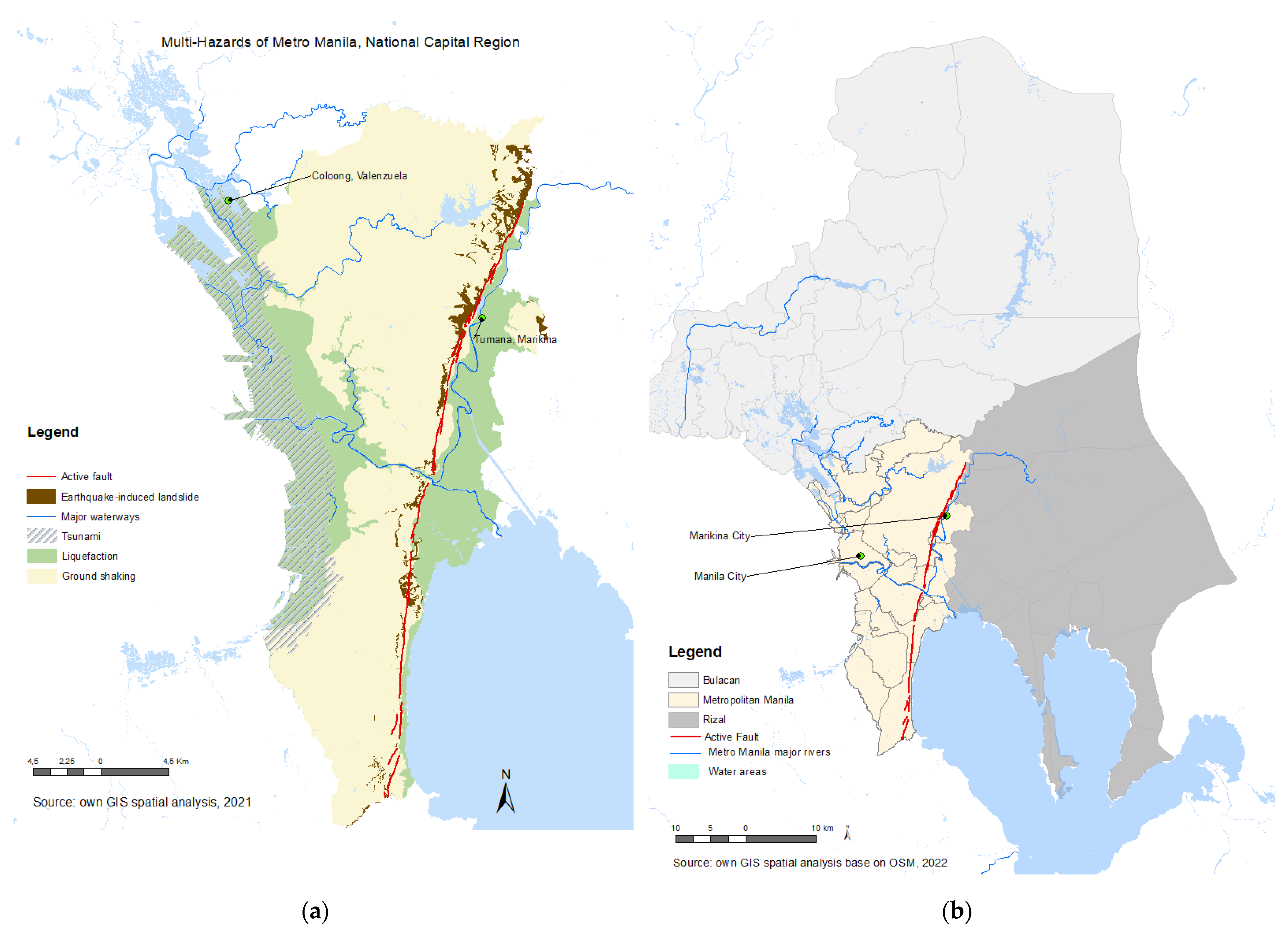
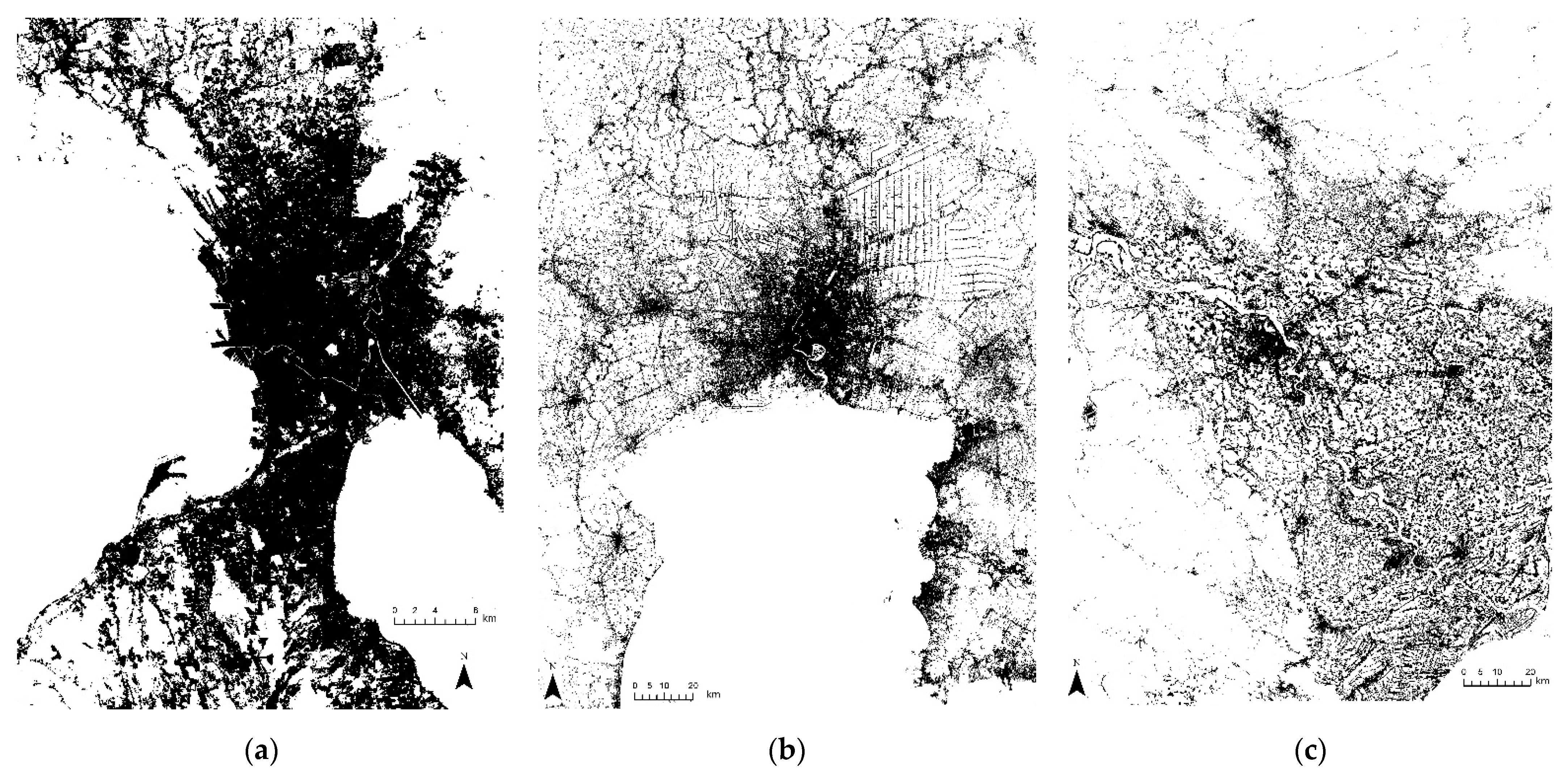
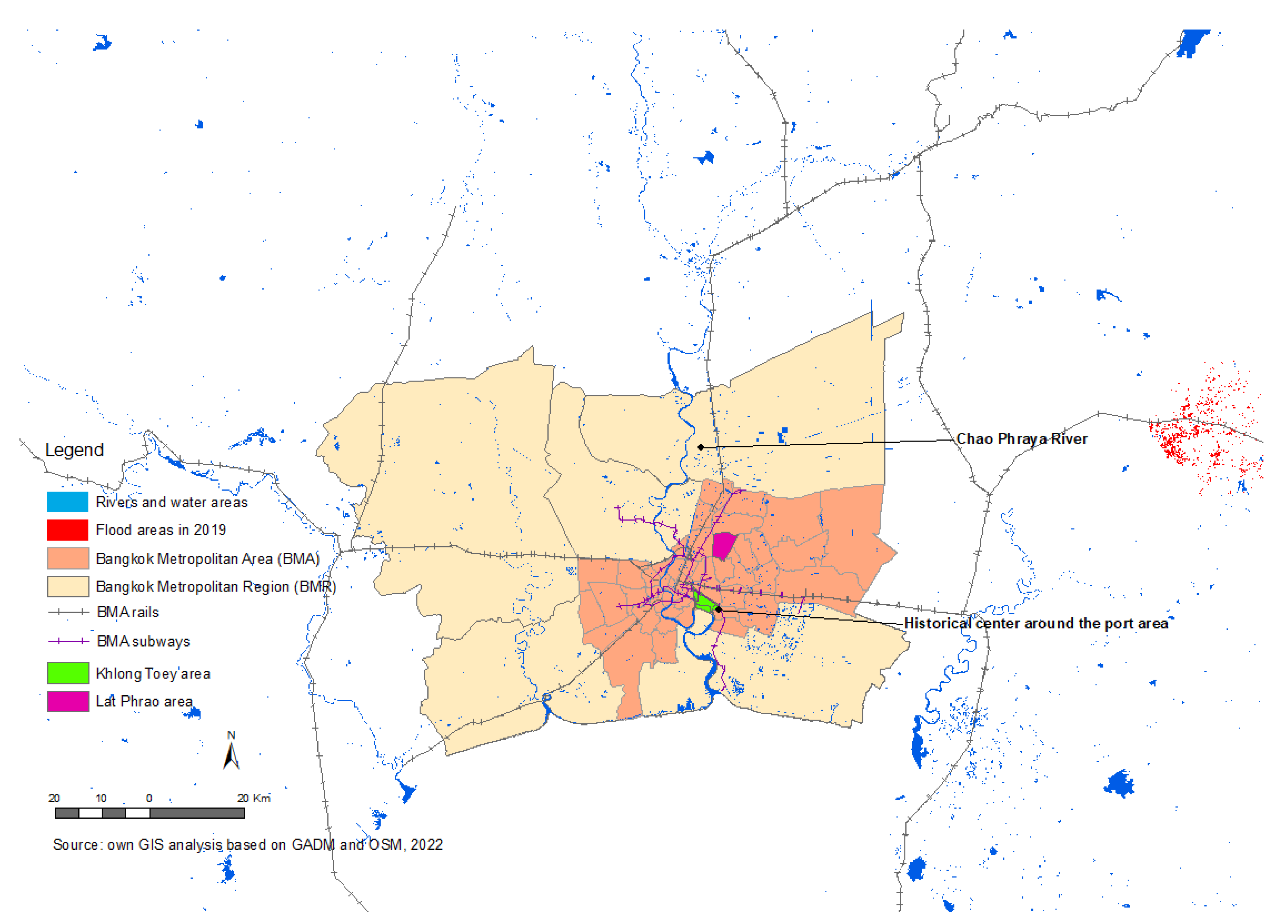
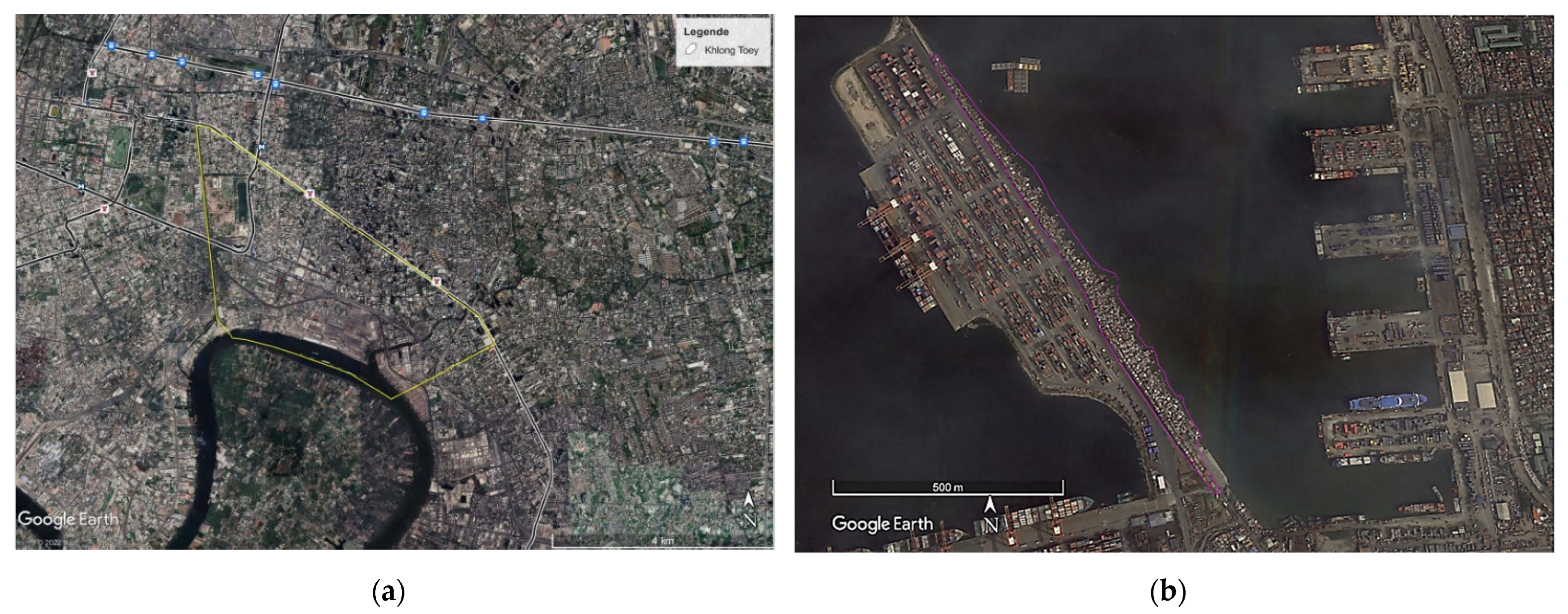
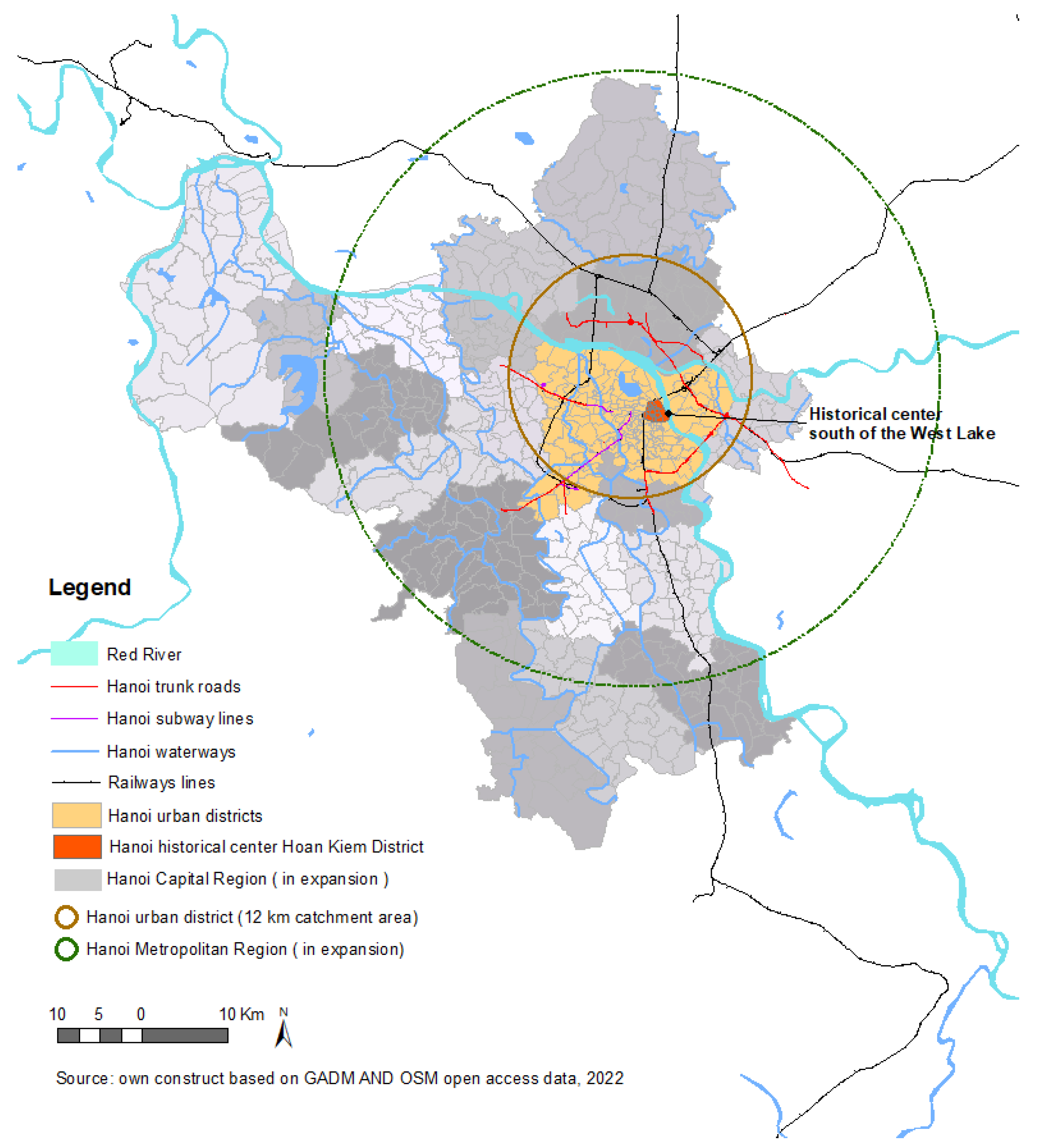
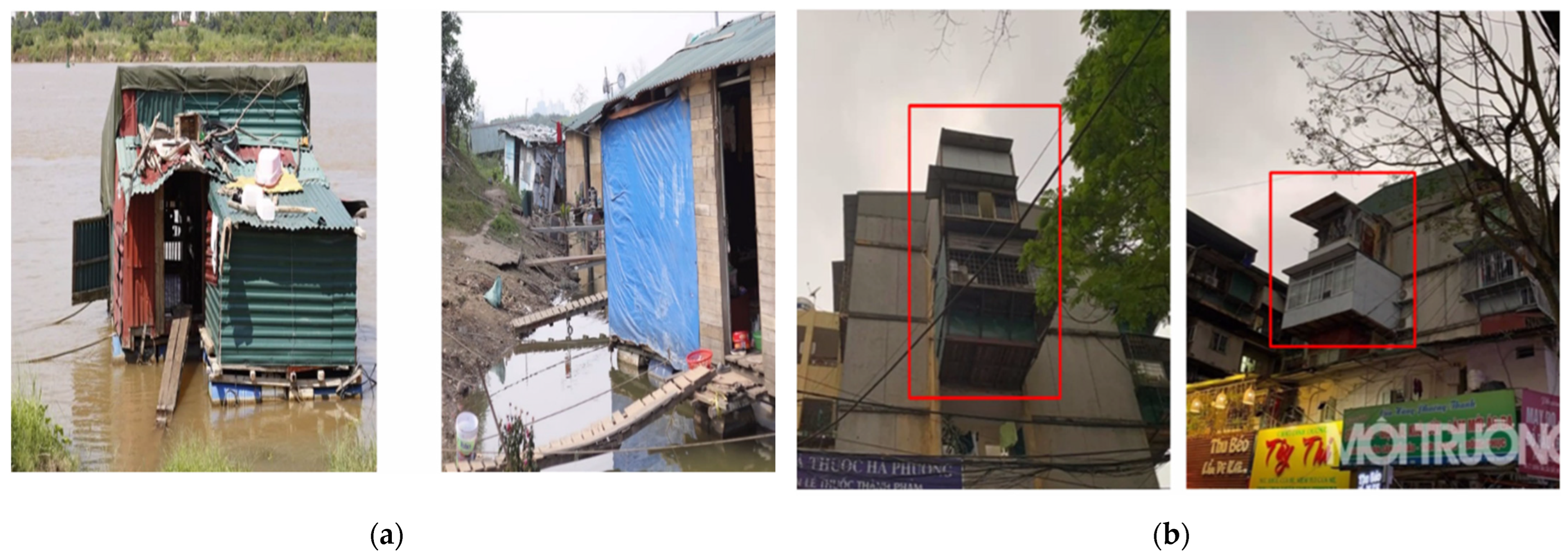
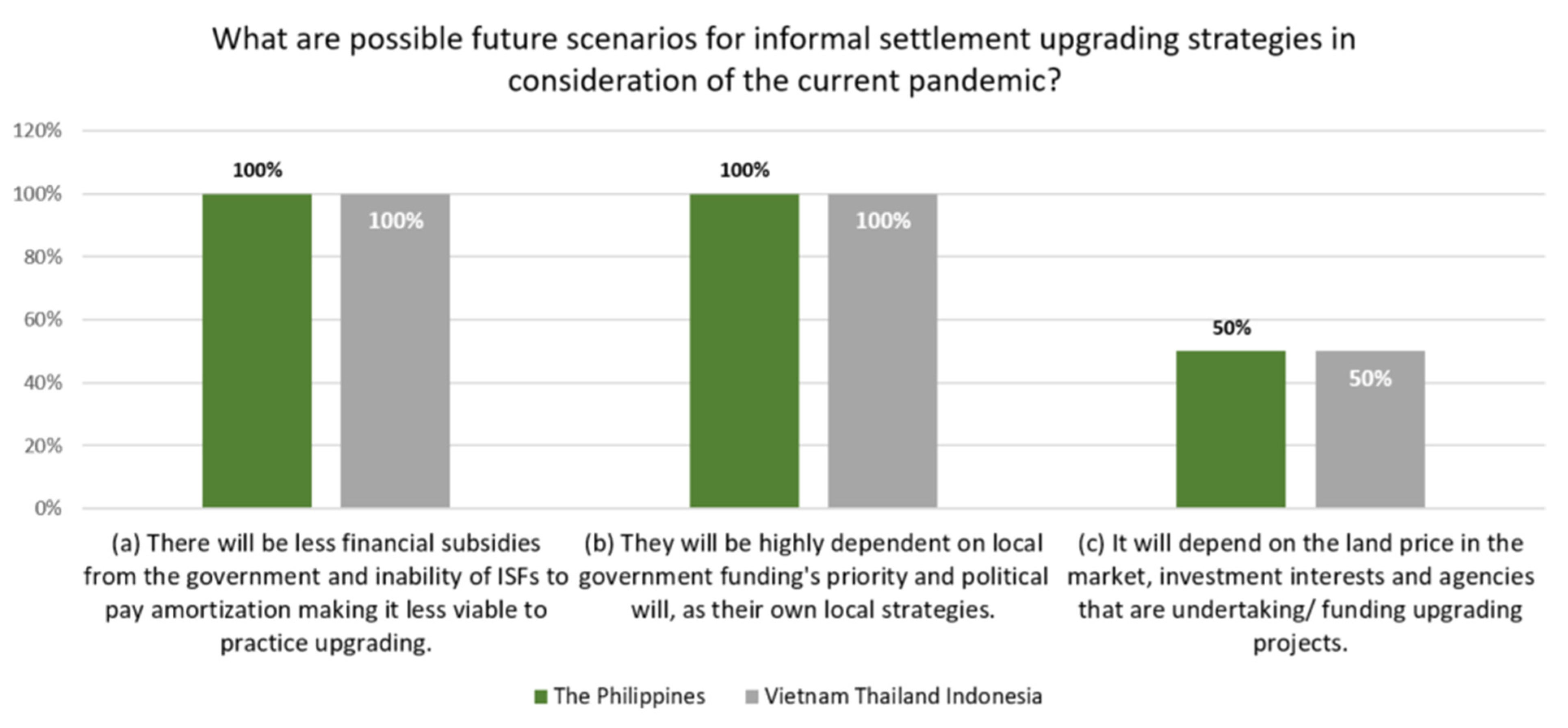
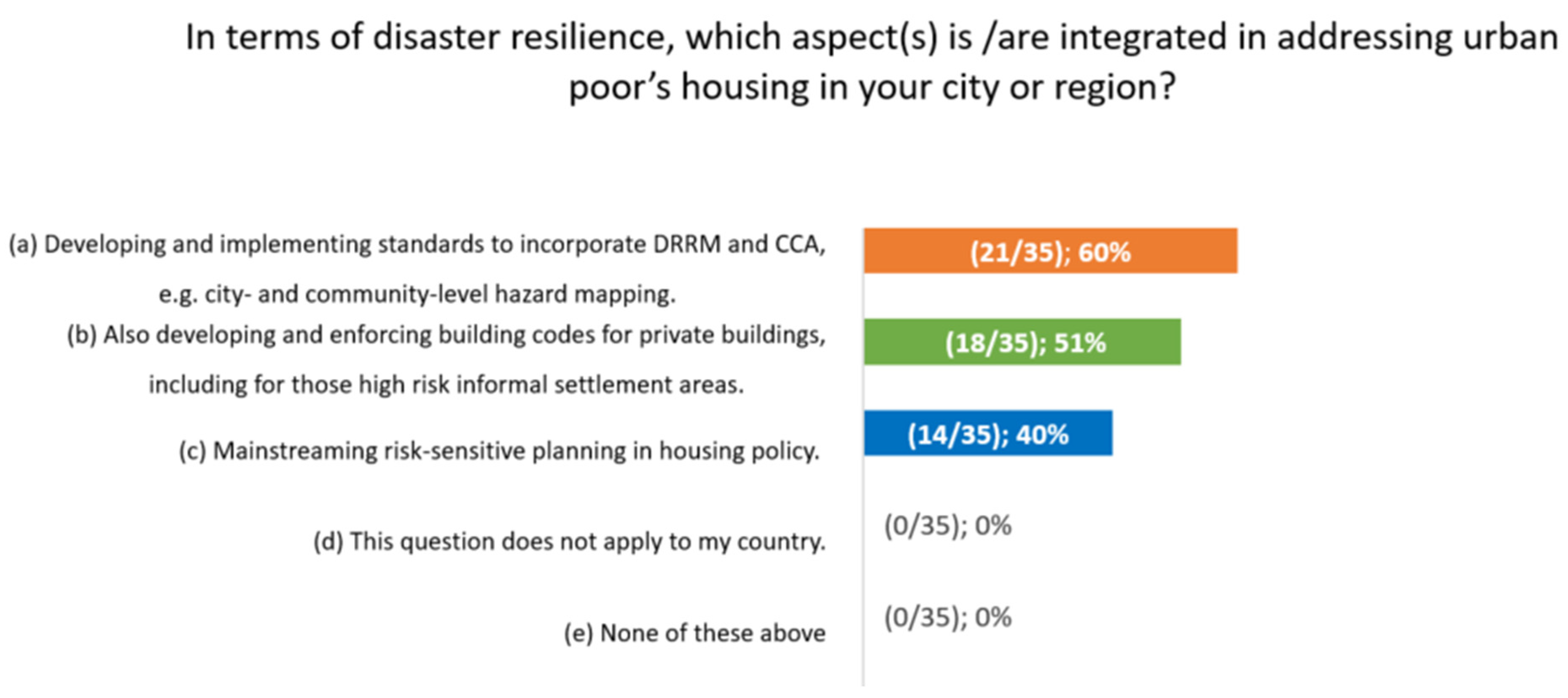
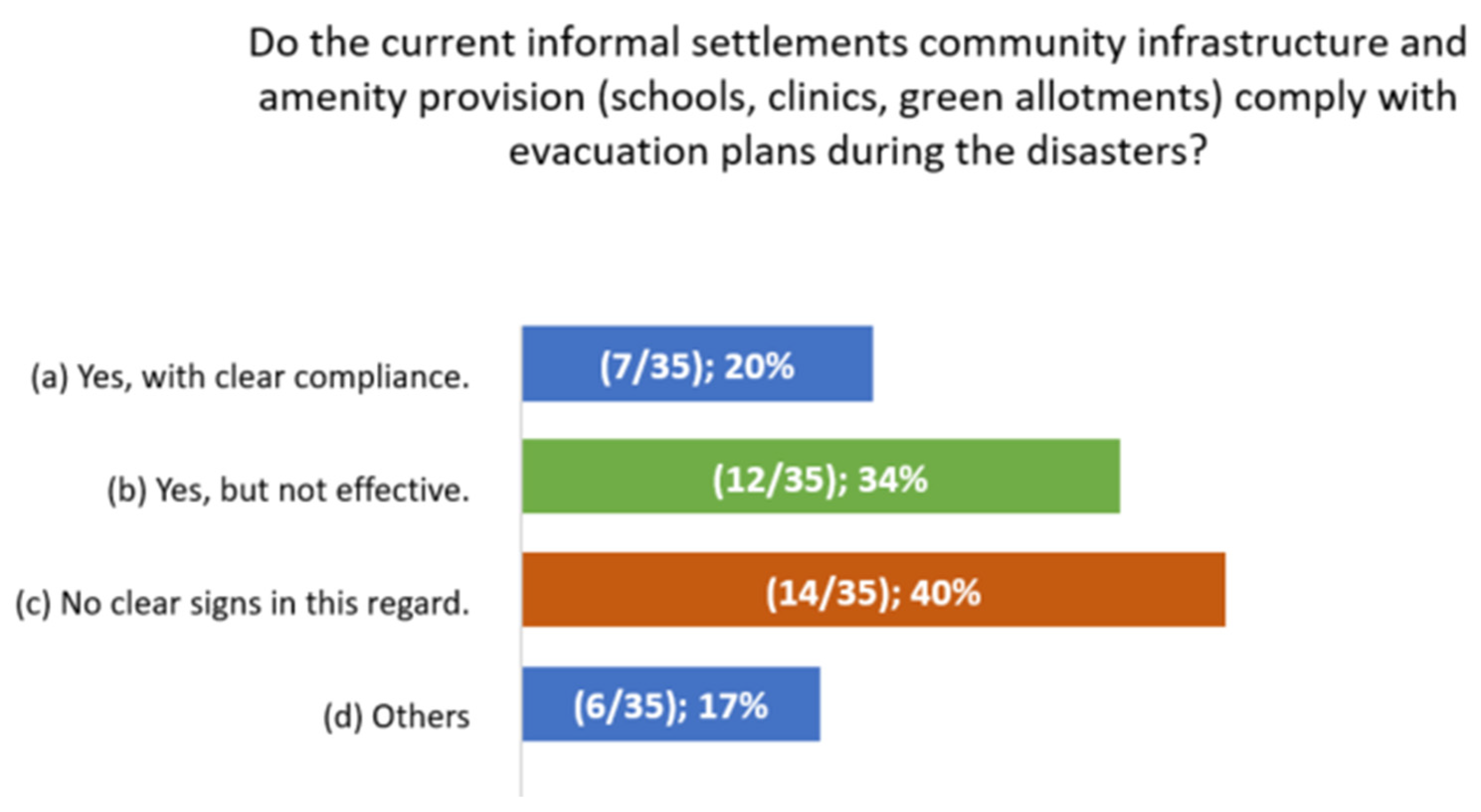
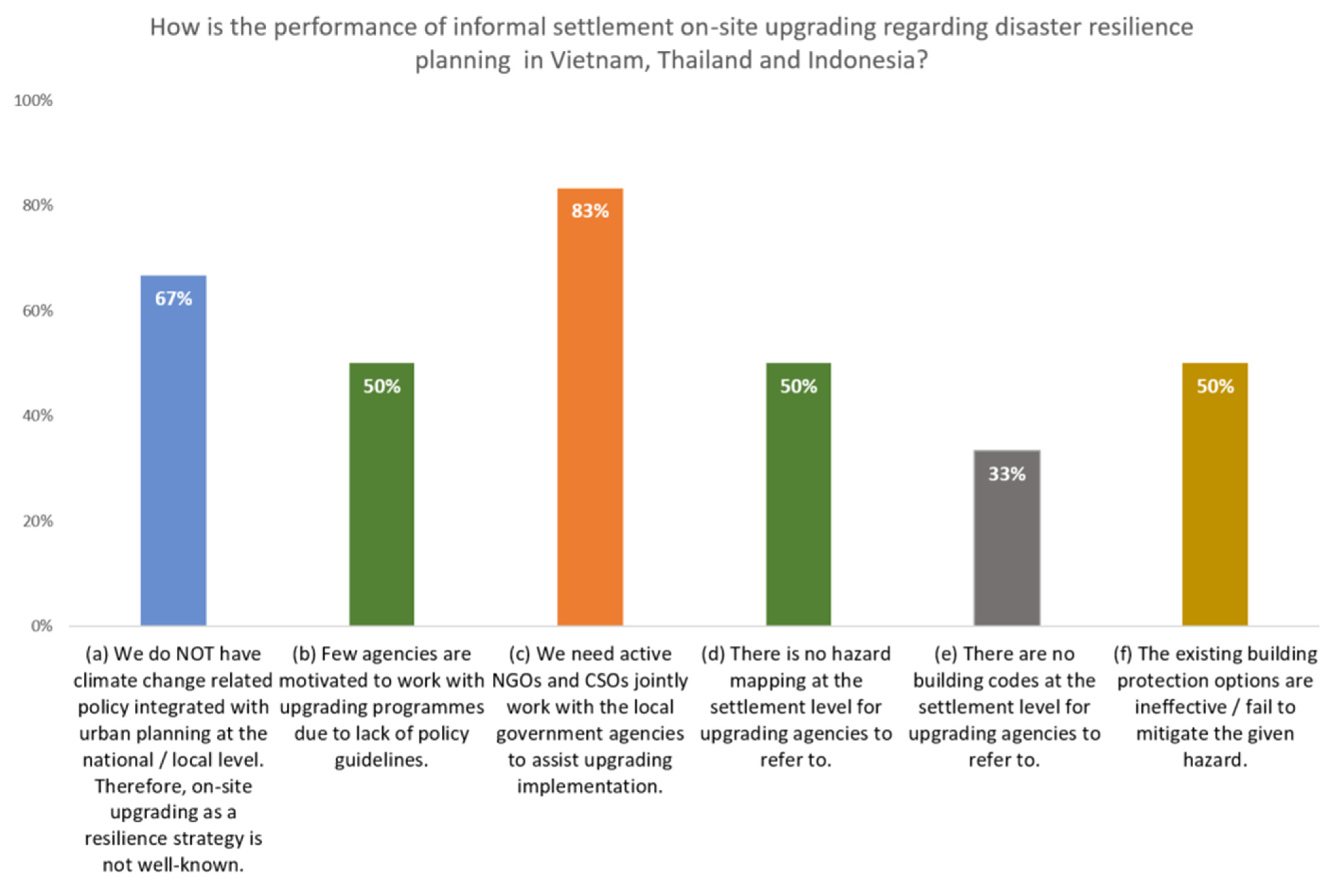
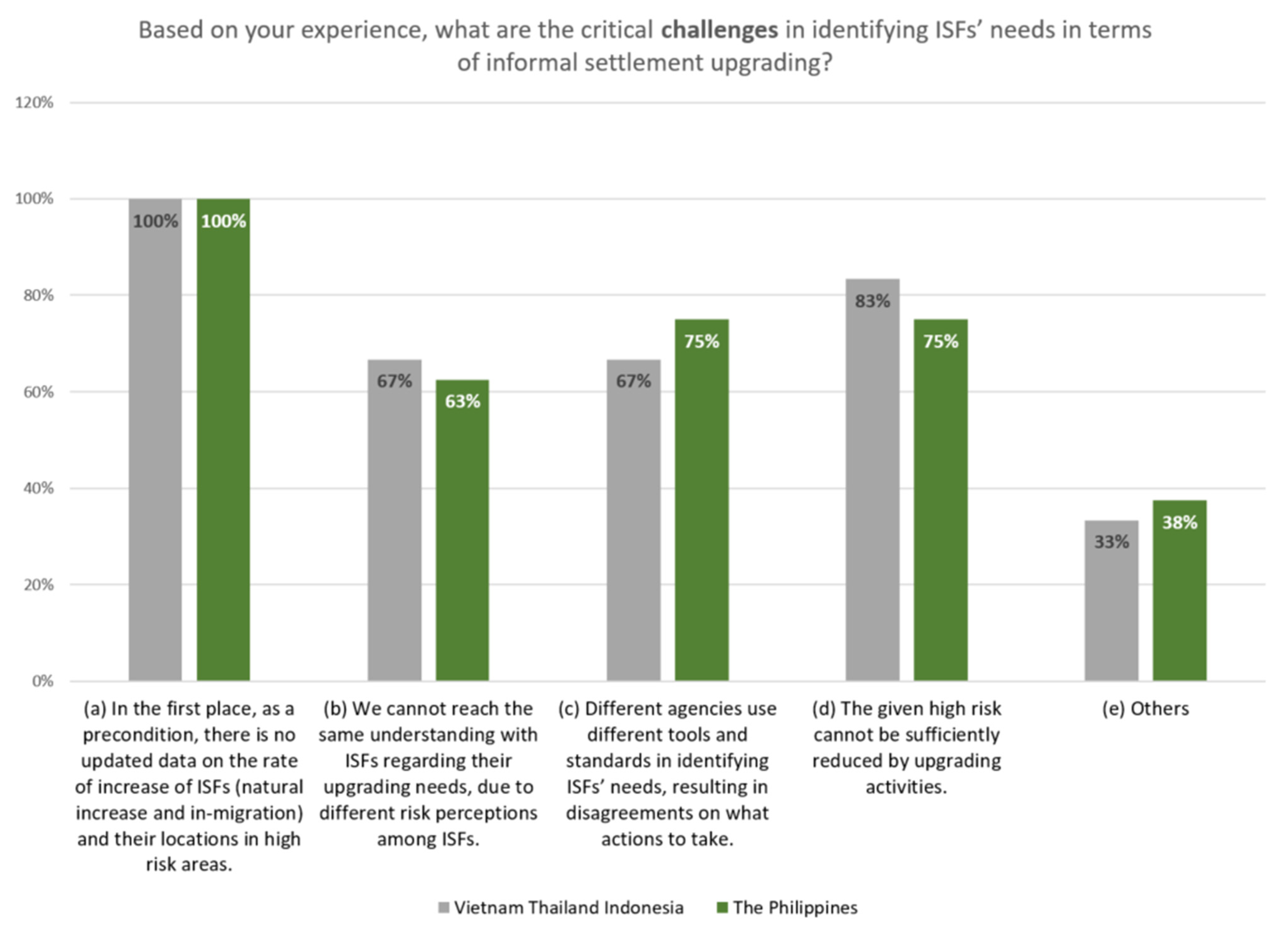
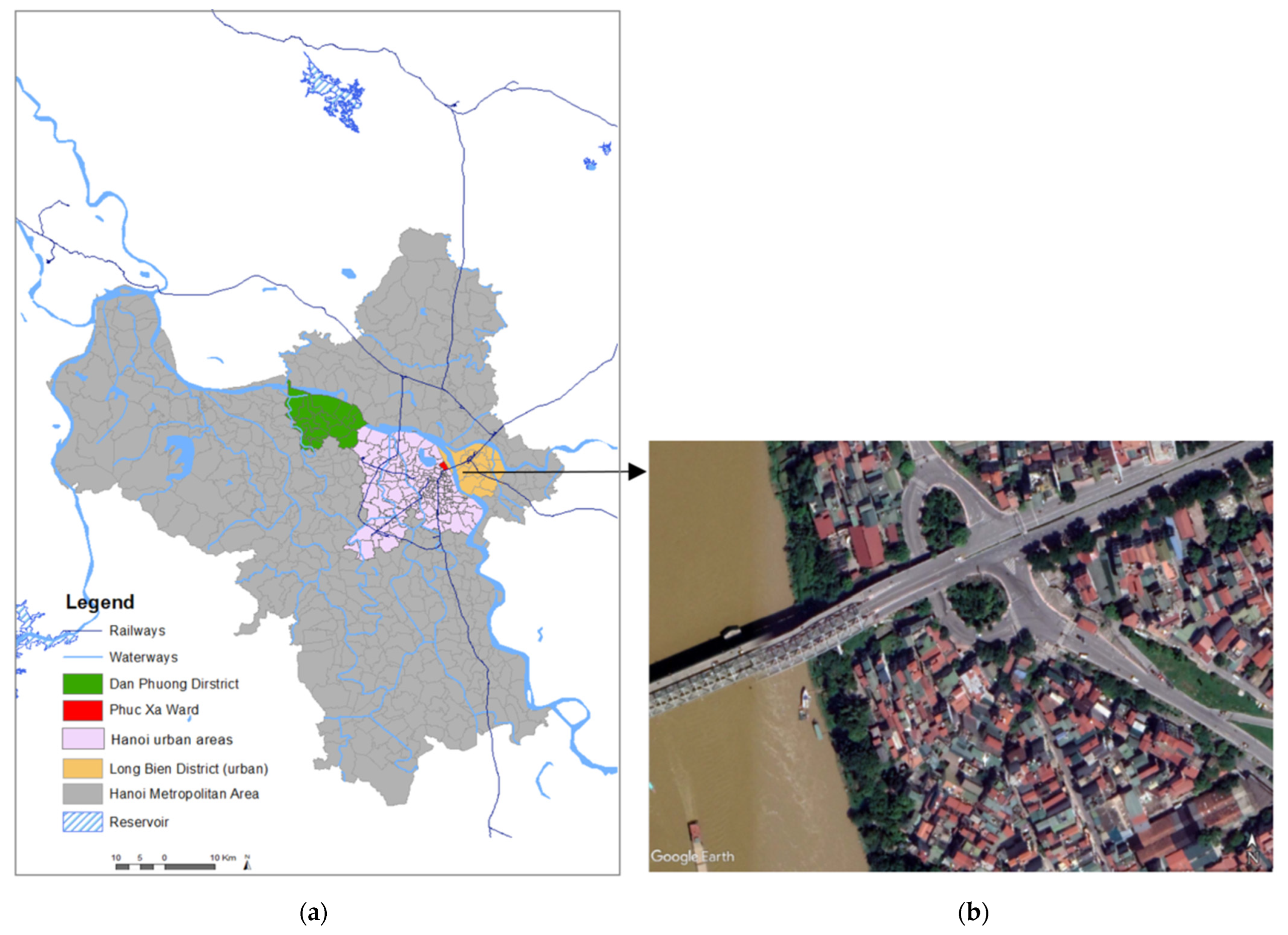
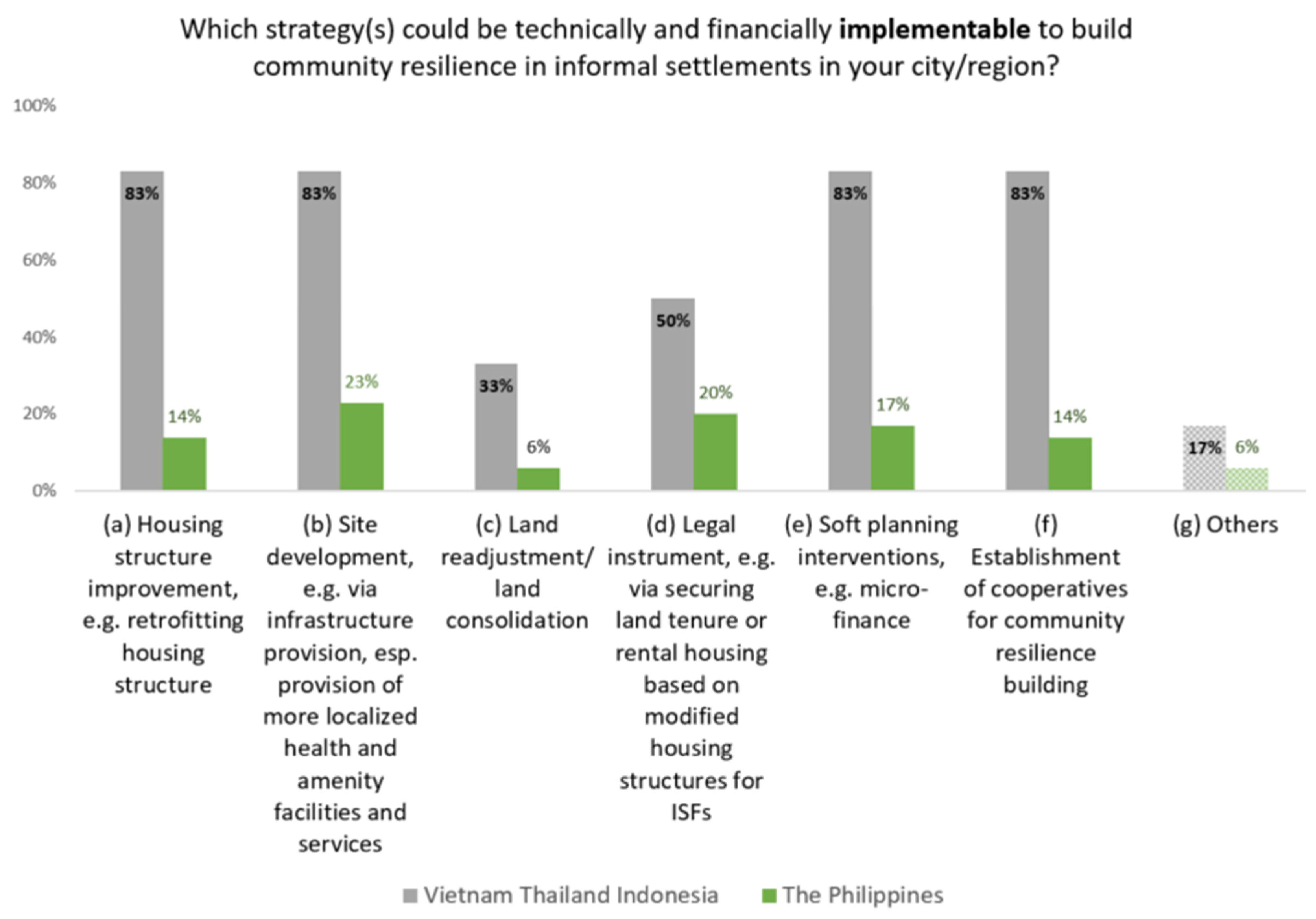
Publisher’s Note: MDPI stays neutral with regard to jurisdictional claims in published maps and institutional affiliations. |
© 2022 by the authors. Licensee MDPI, Basel, Switzerland. This article is an open access article distributed under the terms and conditions of the Creative Commons Attribution (CC BY) license (https://creativecommons.org/licenses/by/4.0/).
Share and Cite
Du, J.; Greiving, S.; Yap, D.L.T. Informal Settlement Resilience Upgrading-Approaches and Applications from a Cross-Country Perspective in Three Selected Metropolitan Regions of Southeast Asia. Sustainability 2022, 14, 8985. https://doi.org/10.3390/su14158985
Du J, Greiving S, Yap DLT. Informal Settlement Resilience Upgrading-Approaches and Applications from a Cross-Country Perspective in Three Selected Metropolitan Regions of Southeast Asia. Sustainability. 2022; 14(15):8985. https://doi.org/10.3390/su14158985
Chicago/Turabian StyleDu, Juan, Stefan Greiving, and David Leonides T. Yap. 2022. "Informal Settlement Resilience Upgrading-Approaches and Applications from a Cross-Country Perspective in Three Selected Metropolitan Regions of Southeast Asia" Sustainability 14, no. 15: 8985. https://doi.org/10.3390/su14158985
APA StyleDu, J., Greiving, S., & Yap, D. L. T. (2022). Informal Settlement Resilience Upgrading-Approaches and Applications from a Cross-Country Perspective in Three Selected Metropolitan Regions of Southeast Asia. Sustainability, 14(15), 8985. https://doi.org/10.3390/su14158985





